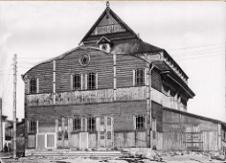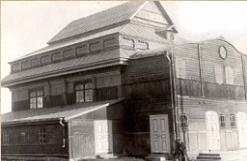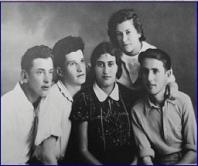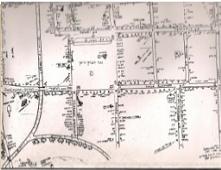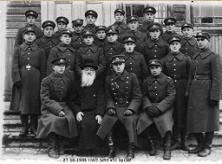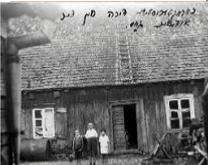Growing Up Under Russian Rule 1815 - 1914 Part 2
Market Square >
VILKAVISKIS
A small town in Southern Lithuania
Where the Jewish Community is no more
MANAGING THE HOUSEHOLD
Even on ordinary days, managing a household in old Vilkaviskis was a chore. A woman‘s job was never done. Besides her household duties, she cared for a large family. A grandmother, Dvore Trivasch, bore and raised five girls and five boys. Most families‘ incomes were slim, and these women who managed large households found ways to economize on food and clothing by reusing goods so that nothing was wasted. The Yiddish-speaking women mingled among their non-Jewish neighbors as they shopped in the market, and thereby, learned to speak bits of Lithuanian and Russian. Middle-class households with young children employed servants, often several at once. The higher the class, the more servants the family had. Most Jewish families had at least one ―maid of-all-work, a non-Jewish peasant girl from a nearby village who lived in the house, did the heavy cleaning, and tended the fires. Typically, she lit the fire on the Sabbath so the Jews could abide by the scripture and avoid work on this Holy Day.
HEATING THE HOUSE
Harsh winters brought the challenge of searching for wood, turf, and old grass to kindle fires and provide warmth. Fuels were burned in brick or tile ovens for heat. Some people experienced headaches from the carbon monoxide fumes of burning turf. Chimneys required cleaning. Accumulated soot in chimneys often caused fires, and many homes burned down. The koymen kerer [chimney cleaner] walked through town with ladders, brooms, brushes, and a long rope to which a weight was tied for pushing out the soot. The chimney cleaner‘s face was usually black from charcoal, and descriptions of his appearance were often associated with an aura of mystery.
CLOTHING
Outgrown or worn-out clothes were turned inside out and made into new garments. Young, single girls sewed for customers in a shop and then they put their earnings into a family fund for their nad‟n [dowry for a groom] and for a trousseau which they collected in a big chest. When women left the house, they wore a huge fatsheyle [huge shawl]. Underneath the fabric, they carried a basket to fill with goods at the market. If someone needed shoes, the shuster [shoemaker] came to the house to take mosn [measurements], which were usually done with a strip of paper by tearing notches to indicate the shoe size. The upper sections of worn out boots were cut off and attached to a new pair of boots. The shtivl [boots], kamashn [gaiters], and knepl shtivl [boots with buttons] took longer to make but also lasted much longer than other types of shoes. Pious Jewish women after marriage wore artistically fashioned wigs. There were no signs of graying hair. In winters, people bundled up with great gray coats made from homespun wool and wore felt boots on their feet.
LAUNDERING
Washing clothes, a time-consuming and difficult task, was done only periodically. Preparation for washing clothes began by catching rainwater into large barrels placed beneath the edge of the shingled roof. Loyg [lye, a mixture of rainwater and wood ashes] created alkaline water for washing. During washdays the home took on a new look. The koymen [fireplace] was completely cleaned out, the chicken coop beneath moved, and a tripod was placed inside the fireplace. Planks of wood were laid near the open brick oven, and large wooden washtubs with plenty of long bars of soap were positioned on the planks. A large copper kesl [kettle] was placed in the fireplace over a tripod. Washerwomen came to the family home. All night professional washerwomen scrubbed and washed. From time to time, they fortified themselves with liberal portions of rozheve [dark bread], herring, and tea. The washing process was simple-they placed the laundry in a copper kettle, where the water was kept boiling, and in the morning the washerwomen took the clothes to the river or the Creek where they rinsed and beat the washed laundry with a prinik (Russian) [wooden grooved trowel]. After completing the rinsing, the washerwomen brought clothes home and hung them to dry, usually in the attic. Other laundry, when partly dry, was carted to the mangler, a person who had a contraption for drying and ironing water-laden cloth that consisted of a large wooden box on rollers and filled with rocks to weigh it down. To keep the linens smooth, they were wrapped around the wooden roller and placed under the mangle, which rolled back and forth by means of a pulley and a large wheel that squeezed out the water. When the clean laundry reached home, mothers mended the clothes and put them away ready for a weekly change.
SAVING MONEY
Women hid coins about the house or kept money tied in their garments in a knipl [little knot]. The secret currency, whether a few paltry Russian gilden or thousands of rubles, was saved by thrifty women for an emergency or for when a nad‟n [dowry] for a marriage was needed. The place where the money was hidden was known only to the woman, but she sometimes forgot the hiding place or the money was lost in a fire.
EARNING A LIVING
Some of the common occupations in Villkaviskis.
Local merchants: of herring, sausage and delicatessen, tobacco, confection, ice cream and soda water, hardware, books, woolen goods, junk, wine, and more Country peddler. Craftsmen: blacksmith and tinsmith, candlemaker, bookbinder, capmaker, wig maker, cloth dyer tailor, seamstress, shoemaker, shoe repairer, printer, photographer, watch repair, jeweler, house builder, carpenter, plasterer. Laborer: pack carrier, chimney cleaner, domestic, washerwoman.
Community service: burial society volunteer, teacher, barber, volunteer firefighter, mailman, banker/ moneylender, carriage driver, watchman, public bath for women.
Food production: grocer, butcher, ritual slaughter, baker.
Professionals: rabbi, synagogue caretaker, lawyer, druggist, medical and folks doctor.
Factory production: sugar, rope from flax and hemp, pop, flour, lumber saw mill.
Miscellaneous: infantry and cavalry soldier, musician, restaurant proprietor, roadhouse owner, beggar, and hotel operator.
The old Tsarist law had prohibited Jews from owning farmland so there were only a few Jewish farmers. Nevertheless, some city Jews rented land where they could plant vegetables.


